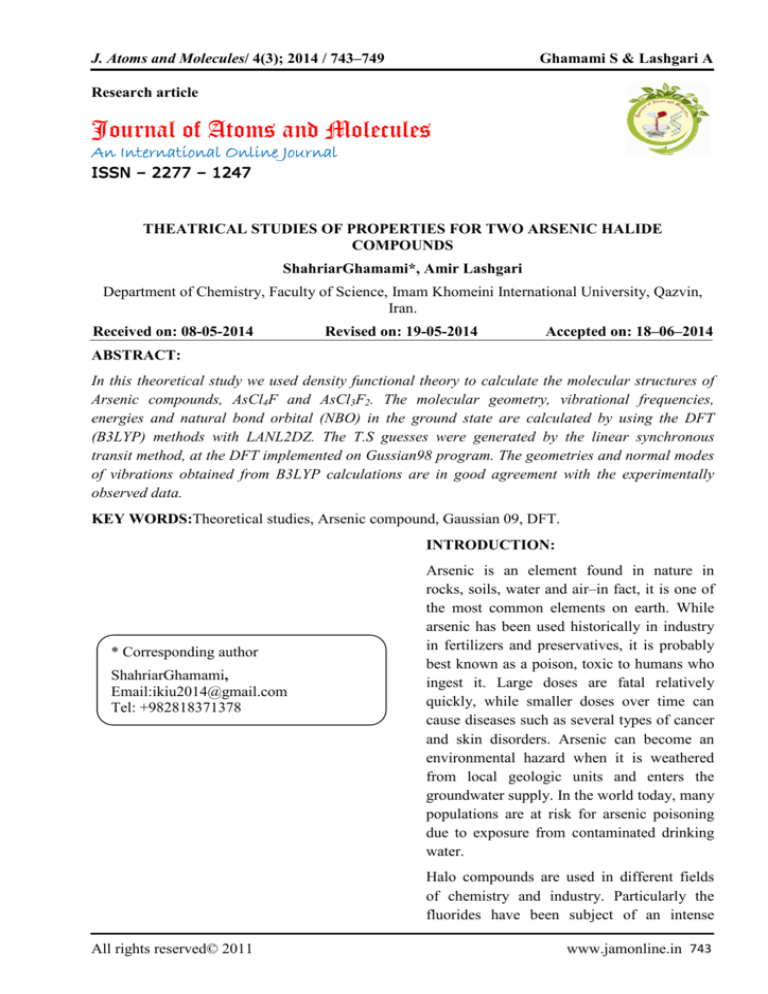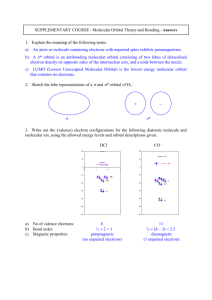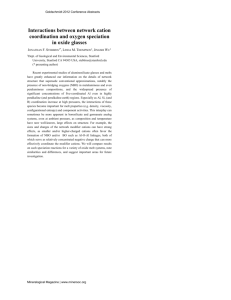
J. Atoms and Molecules/ 4(3); 2014 / 743–749
Ghamami S & Lashgari A
Research article
Journal of Atoms and Molecules
An International Online Journal
ISSN – 2277 – 1247
THEATRICAL STUDIES OF PROPERTIES FOR TWO ARSENIC HALIDE
COMPOUNDS
ShahriarGhamami*, Amir Lashgari
Department of Chemistry, Faculty of Science, Imam Khomeini International University, Qazvin,
Iran.
Received on: 08-05-2014
Revised on: 19-05-2014
Accepted on: 18–06–2014
ABSTRACT:
In this theoretical study we used density functional theory to calculate the molecular structures of
Arsenic compounds, AsCl4F and AsCl3F2. The molecular geometry, vibrational frequencies,
energies and natural bond orbital (NBO) in the ground state are calculated by using the DFT
(B3LYP) methods with LANL2DZ. The T.S guesses were generated by the linear synchronous
transit method, at the DFT implemented on Gussian98 program. The geometries and normal modes
of vibrations obtained from B3LYP calculations are in good agreement with the experimentally
observed data.
KEY WORDS:Theoretical studies, Arsenic compound, Gaussian 09, DFT.
INTRODUCTION:
* Corresponding author
ShahriarGhamami,
Email:ikiu2014@gmail.com
Tel: +982818371378
Arsenic is an element found in nature in
rocks, soils, water and air–in fact, it is one of
the most common elements on earth. While
arsenic has been used historically in industry
in fertilizers and preservatives, it is probably
best known as a poison, toxic to humans who
ingest it. Large doses are fatal relatively
quickly, while smaller doses over time can
cause diseases such as several types of cancer
and skin disorders. Arsenic can become an
environmental hazard when it is weathered
from local geologic units and enters the
groundwater supply. In the world today, many
populations are at risk for arsenic poisoning
due to exposure from contaminated drinking
water.
Halo compounds are used in different fields
of chemistry and industry. Particularly the
fluorides have been subject of an intense
All rights reserved© 2011
www.jamonline.in 743
J. Atoms and Molecules/ 4(3); 2014 / 743–749
scientific discussion since the first synthesis
of such a compound [1-2]. This is because of
the important prerequisites for fluorinating
agents to be useful which are theirs mildness,
versatility, selectivity and operational
simplicity. The subject of this investigation is
prepared inorganic fluorides and complexes
[3]
.The halo compounds have been utilized in
bioinorganic chemistry as reagents for
synthesizing some model compounds. The
unique properties of halide impart an unusual
reactivity to the fluoride bonds which can be
exploited in preparative inorganic chemistry
or in catalysis. In recent years there has been a
great deal of interest in the halo compounds.
Investigation of the structures and properties
of these compounds and their similarities are
interested. In this work, we report on the
synthesis and characterization of new
complexes of Arsenic such as AsCl4F and
AsCl3F2. During this study we report the
optimized geometries and infrared spectral
measurements; assignments and electronic
structure calculations for compounds. The
structures of compounds have been optimized
by using the DFT (B3LYP) method with the
LANL2DZ basis set. Seppelt synthesized
three new Arsenic compounds and in this
paper we investigated other properties of them
[4-13]
.
MATERIALS AND METHODS:
Computational Method
All computational are carried out using
Gaussian 09 Rev. A.01 program [14-15] which
combines the exact Hartree-Fock exchange
with Becke,s and uses the Lee-Yang-Parr
correlation function in order to include the
most important correlation effects. The
structures of the molecules were completely
optimized without any symmetry in all the
levels. The optimized structural parameters
were used in the vibrational frequency
calculations at the DFT levels to characterize
All rights reserved© 2011
Ghamami S & Lashgari A
all stationary points as minima. Infrared
intensities (int) in Kilometer per mole of all
compounds were performed at the same level
on the respective fully optimized geometries.
These compounds and their data are in
accordance with recent works on the
formation of four coordinate intermediates.
RESULTS:
The Halo compounds, AsCl4F and AsCl3F2,
were studied and geometry optimizations
were performed at the DFT/LANDL2Z level
and are shown in Figure. 1. The AsCl4F, in
which Cl3, Cl5 and Cl6 is bonded to the As
atom, has a linear Cl–As structure with bond
length 2.28Å and has a bent Cl3–As–Cl5
structure with a bond angle of 119.92° and in
the AsCl3F2 in which Cl4, Cl5, Cl6 is bonded
to the As atom, has a linear As–Cl structure
with bond length 2.25Å and has a bent Cl4–
As–Cl6 structure with a bond angle of 120°.
Selected bond distances are illustrated in
Figure.1. Selected angles are reported in
Table 1. Both the highest occupied molecular
orbital (HOMO) and lowest unoccupied
molecular orbital (LUMO) are the main
orbitals that take part in chemical stability.
The HOMO represents the ability to donate an
electron, LUMO as an electron acceptor
represents the ability to obtain an electron the
HOMO and LUMO energy calculated by
B3LYP at LANDL2Z method Figure.2. This
electronic absorption corresponds to the
transition from the ground to the first excited
state and is mainly described by one electron
excitation from the highest occupied
molecular or orbital (LUMO). Atomic charges
and bond orders are significant parameters for
our investigation. These quantities are derived
from the NBO population analysis. The NBO
method is preferred to Mulliken charges,
because the former provides an orbital picture
that is closer to the classical Lewis structure.
The NBO analysis involving atomic charges,
bond orders as well as hybridizations of
www.jamonline.in 744
J. Atoms and Molecules/ 4(3); 2014 / 743–749
selected
bonds
are
calculated
at
B3LYP/LANDL2Z
level.
The
NBO
calculated hybridization for AsCl4F and
AsCl3F2 shows that all of compounds have
hybridization
and
non-planar
SPX
configurations. The total hybridization of
these molecules are SPxthat confirmed by
structural(Table 2).Second order perturbation
theory analysis of Fock matrix in NBO basis
for AsCl4F and AsCl3F2 is shown in table
3.These molecules have distorted Td
symmetries
DISCUSSION:
The geometries of compounds were optimized
at B3LYP/LANDL2Z levels. Density
functional theory methods were employed to
determine the optimized structures of AsF5,
AsCl4F and AsCl3F2. Initial calculations were
performed at the DFT level and split- valence
plus polarization LANDL2Z basis sets were
used. Local minima were obtained by full
geometrical optimization have all positive
frequencies. All calculations were carried out
using the computer program GAUSSIAN 98.
NBO study on structures
Natural Bond Orbital's (NBOs) are localized
few-center orbital's that describe the Lewislike molecular bonding pattern of electron
pairs in optimally compact form. More
precisely, NBOs are an orthonormal set of
localized "maximum occupancy" orbital's
whose leading N/2 members (or N members
in the open-shell case) give the most accurate
possible Lewis-like description of the total Nelectron density. This analysis is carried out
by examining all possible interactions
between "filled" (donor) Lewis-type NBOs
and "empty" (acceptor) non-Lewis NBOs, and
estimating their energetic importance by 2ndorder perturbation theory. Since these
interactions lead to donation of occupancy
from the localized NBOs of the idealized
Lewis structure into the empty non-Lewis
All rights reserved© 2011
Ghamami S & Lashgari A
orbitals (and thus, to departures from the
idealized Lewis structure description), they
are referred to as "delocalization" corrections
to the zeroth-order natural Lewis structure.
Natural charges have been computed using
natural bond orbital (NBO) module
implemented in Gaussian98. The NBO
Calculated Hybridizations are significant
parameters for our investigation. These
quantities are derived from the NBO
population analysis. The former provides an
orbital picture that is closer to the classical
Lewis structure. The NBO analysis involving
hybridizations of selected bonds are
calculated at B3LYP methods and
LANDL2DZ level of theory.
These data shows the hyper conjugation of
electrons between ligand atoms with central
metal atom.
Frontier molecular orbital
Both the highest occupied molecular orbital
(HOMO) and lowest unoccupied molecular
orbital (LUMO) are the main orbital take part
in chemical stability. The HOMO represents
the ability to donate an electron, LUMO as an
electron acceptor represents the ability to
obtain an electron. The HOMO and LUMO
energy were calculated by B3LYP/LANL2DZ
method.
This
electronic
absorption
corresponds to the transition from the ground
to the first excited state and is mainly
described by one electron excitation from the
highest occupied molecular or orbital
(LUMO). Therefore, while the energy of the
HOMO is directly related to the ionization
potential, LUMO energy is directly related to
the electron affinity. Energy difference
between HOMO and LUMO orbital is called
as energy gap that is an important stability for
structures.
www.jamonline.in 745
J. Atoms and Molecules/ 4(3); 2014 / 743–749
CONCLUSION:
In this research the number of new
compounds was chosen to theoretical studies.
In this paper, the optimized geometries and
frequencies of the stationary point and the
minimum-energy paths are calculated by
using the DFT (B3LYP) methods with
LANL2DZ basis sets. The geometries and
normal modes of vibrations obtained from
B3LYP calculations are in good agreement
with the experimentally observed data.
ACKNOWLEDGEMENT:
We gratefully acknowledge the financial
support from the Research Council of Imam
Khomeini International University.
REFERENCES:
1) Smith, M.C., Ciao, Y., Wang, H., George,
S.J., Coucouvanis, D.,Koutmos,
M.,
Sturhahn, W., Alp, E.A., Zhao, J., and
Kramer, S.P. (2005) Normal-Mod
Analysis of FeCl4- and Fe2S2Cl42- via
Vibrational
Massbauer,
Resonance
Raman,
andFT-IR
Spectroscopies,
Inorganic Chemistry, 44, 5562-5570
2) Vrajmasu VV. ,Mu¨nck E., &Bominaar
EL., (2004). Theory of mono- and
polynuclear transition metal complexes
and metalloproteins. J. Inorg. Chem,43,
4862–4866
3) Ghammamy, Sh., Anvarnia, Z., Jafari ,M.,
Mehrani K., Tavakol, H., Javanshir, Z.,
andRezaeibehbahani, G.(2009) Synthesis
and characterization of two new halo
complexes of iodine: (C4H9)4N[I2Br]and (C4H9)4N[I2Cl]- and theoretical
calculations of their structures. Main
Group Chemistry, 8, 299-306.
4) Seppelt, K. (1973). Halogenderivate der
Pentafluoroorthoselensäure,
Chem.
Ber.106, 157
5) Seppelt, K. (1973). Neue Derivate der
Pentafluoroorthoselensäure,
Halogenderivate
derPent
All rights reserved© 2011
Ghamami S & Lashgari A
afluoroorthotellursäure, Chem. Ber. 106,
1920
6) Seppelt,
K.,
Sundermeyer,
W.,
Darstellung ,Über und des, Eigenschaften.
(1969)
Tetrakistrimethylsilylhydrazins
und
anderersilylsubstituierter,
Hydrazine
Chem. Ber.,
102, 1247-1252.
7) Seppelt, K., Sundermeyer, W.(1969) .NHalogensulfinylamine,
Naturwissenschaften,
56, 281-282.
8) Seppelt, K., Sundermeyer, W. (1969).
EineneueMethodezurDarstellung
von
Halogenaminen, Z. Naturf. 24, 774-785.
9) Seppelt, K., Sundermeyer, W. (1969).
Über N-Halogenimidoschwefeldifluoride
und
N,N'Dihalogenschwefeldiimide,Angew. Chem.
81, 785-786.
10) Seppelt, K., Sundermeyer, W. (1970)
NotizüberMetalltris(trimethylsilyl)hydrazi
de, Chem. Ber Chem. Ber. 103, 39393941.
11) Seppelt, K., und, H. H. Eysel, Z. anorg.
(1971).
Schwingungsspektren
und
Kraftkonstanten
des
Tetrakistrimethylsilylhydrazin,
allg.
Chem. 384, 147-154.
12) Seppelt, K., Sundermeyer, W. (1970)
NeueImidoschwefeloxiddifluorideAngew.
Chem. 82, 931-955.
13) Seppelt, K., Sundermeyer, W. (1971). NHalogenimidoschwefeloxiddifluoride, Z.
Naturf. 26, 65-73.
14) Frisch,
M.J.,
Trucks
G.W..,1998.
GASSIAN 98 (Revision A. 3) Gaussian
Inc, Pittsburgh,PA, USA,
15) Christe, K.O.,Wilson, WW., Wilson,
R.D., Bau, R.,. (1990) Syntheses,
Properties, andStructures of Anhydrous
Tetramethylammonium Fluoride and Its
1:1 Adduct with
trans-3-Amino-2butenenitrile, Am. Chem. Soc., 112, 76197625.
www.jamonline.in 746
J. Atoms and Molecules/ 4(3); 2014 / 743–749
Ghamami S & Lashgari A
Tables and Figures:
(1)(2)
Figure 1. Optimized geometries of (1) [ASCl4F], (2) [ASCl3F2], at B3LYP/LANL2Z level of
theory.
ELUMO = - 0.23799 a.u(First excited state)
∆E = 0.12116 a.u(Ground state)
EHOMO = -0.34915 a.u(Ground state)
(1)
All rights reserved© 2011
www.jamonline.in 747
J. Atoms and Molecules/ 4(3); 2014 / 743–749
Ghamami S & Lashgari A
ELUMO = 0.20795 a.u(First excited state)
∆E = 0.11583 a.u(Ground state)
EHOMO = -0.32375 a.u(Ground state)
(2)
Figure 2.The atomic orbital of the frontier molecular orbital for (1) [ASCl4F], (2) [ASCl3F2].
Table 1.Geometrical parameters optimized for (1) [ASCl4F] (2) [ASCl3F2] bond length (Å) and
angle (◦).
[ASCl4F]
[ASCl3F2]
Bonds
Lengths (Å)
Bonds
Lengths (Å)
As-F2
As-Cl3
As-Cl4
As-Cl5
As-Cl6
Bonds
F2-As-Cl3
F2-As-F5
F2-As-F6
lC4-As-C6
lC3-As-Cl4
lC4-As-F5
lC3-As-Cl5
lC3-As-Cl6
Cl5-As-Cl6
1.81
2.28
2.37
2.28
2.28
Angles (◦)
88.45
88.45
88.45
91.54
91.54
91.54
119.92
119.92
119.92
As-F2
As-F3
As-Cl4
As-Cl5
Cl6-As
Bonds
F2-As-Cl4
F2-As-Cl5
F2-As-Cl6
F3-As-Cl4
F3-As-Cl5
F3-As-Cl6
Cl4-As-Cl5
Cl4-As-Cl6
Cl5-As-Cl6
1.82
1.82
2.25
2.25
2.25
Angles (◦)
90
90
90
90
90
90
120
120
120
All rights reserved© 2011
www.jamonline.in 748
J. Atoms and Molecules/ 4(3); 2014 / 743–749
Ghamami S & Lashgari A
Table 2.The NBO Calculated Hybridizations for (1) [ASCl4F] (2) [ASCl3F2] at the
B3LYP/LANL2Z.
[ASCl4F]
Bond
As-Cl3
As-Cl4
As-Cl5
Cl4
B3LYP
S1P2.48
S1P14.55
S1P6.29
S1P21.96
S1P2.48
S1P14.55
[ASCl3F2]
Bond
B3LYP
Bond
As-Cl6
S1P2.48
S1P14.55
As-F3
F2
S1P0.17
As-Cl4
Cl3
S1P0.07
As-Cl5
S1P0.05
Cl5
B3LYP
S1P5.48
S1P7.12
S1P2.55
S1P13.75
S1P2.55
S1P13.75
Bond
B3LYP
As-Cl6
S1P2.55
S1P13.75
F2
S1P3.36
Cl2
S1P5.58
S1P7.08
S1P3.35
Table 3.Second order perturbation theory analysis of Fock matrix in NBO basis for [ASCL4F] and
[ASCL3F2].a E(2) means energy of hyper conjugative interaction (stabilization energy); b Energy
difference between donor and acceptor i and j NBO orbital's; c F(i, j) is the Fock matrix element
between i and j NBO orbital's.
Donor (i)
Type
ED/e
Acceptor
(j)
Type
ED/e
E(2)a(KJ/
mol)
E(j)‐‐E(i)b(
a.u)
F(i,j)c
(a.u)
σ
σ
σ
σ
σ
n
n
0.92633
0.96680
0.92633
0.96680
0.96680
0.99070
0.98786
AsCl4
AsCl6
AsCl6
AsCl4
AsCl5
AsCl4
AsCl5
σ*
σ*
σ*
σ*
σ*
σ*
σ*
0.16263
0.15154
0.15154
0.16263
0.15154
0.16263
0.15154
1.89
1.80
2.82
4.63
1.80
3.33
1.68
0.40
0.45
0.38
0.47
0.45
0.23
0.20
0.036
0.038
0.043
0.063
0.038
0.038
0.025
σ
σ
σ
σ
n
n
n
n
0.96685
0.96529
0.96529
0.96529
0.98060
0.98361
0.98360
0.98266
AsCl6
AsCl5
AsCl6
AsCl4
AsCl5
AsF3
AsCl4
AsCl5
σ*
σ*
σ*
σ*
σ*
σ*
σ*
σ*
0.13809
0.13809
0.13809
0.13809
0.13809
0.15755
0.13809
0.13809
1.61
1.78
1.78
1.78
2.26
3.70
4.04
4.04
0.61
0.46
0.46
0.46
0.29
0.29
0.22
0.22
0.042
0.038
0.038
0.038
0.034
0.044
0.040
0.040
[ASCL4F]
AsCl4
AsCl3
AsCl4
AsCl6
AsCl3
Cl3
Cl4
[ASCL3F2]
AsF3
AsCl4
AsCl5
AsCl6
F3
Cl4
Cl5
Cl6
How to cite this article:
Ghamami S.,Lashgari A.,“Theatrical Studies of Properties for Two New Arsenic Halide
Compounds” J. Atoms and Molecules, 4(3), 2014: 743– 749.
All rights reserved© 2011
www.jamonline.in 749







